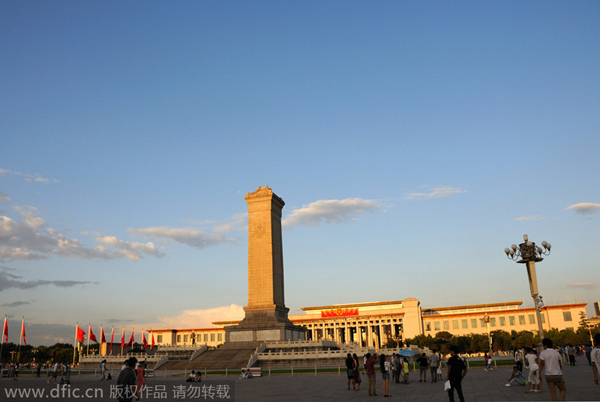Surrounding areas of Tianjin and Hebei still falling short of the mark
|
 |
| A view of the Tian'anmen Square against clear sky in this August file photo. [Photo/IC] |
PM2.5 refers to particles about 100 times thinner than a human hair that are small enough to enter the lungs and bloodstream.

However, the current measures could only help lower the annual average PM2.5 concentration by about 19 percent in neighboring Tianjin and by about 15 percent in Hebei, said the report released by Tsinghua University and the Clean Air Alliance of China.
According to the Air Pollution Prevention and Control Action Plan issued by the State Council in 2013, the concentration of PM2.5 in the Beijing-Tianjin-Hebei region should be reduced by 25 percent by 2017 and annual concentration in Beijing should not exceed 60 micrograms per cubic meter.
The action plan set specific targets for the region's energy consumption. By 2017, coal consumption in the region should be reduced by 63 million metric tons and natural gas consumption increased by 50 billion cubic meters.
"The existing policies could bring an obvious change to the Beijing-Tianjin-Hebei region's PM2.5 concentration level, but more stringent measures should be implemented to ensure the region realizes its concerted goal," said He Kebin, a professor at Tsinghua University's School of Environment who managed the project.
Measures such as cutting steel output have slowed economic growth in Hebei, but local officials have been keen to take more ambitious measures, He said.
He said controlling air pollution requires measures such as capping coal consumption and using alternative energies, as well as measures such as desulfurization and denitration.
For instance, He suggested that Hebei province could further cut its steel output to realize an additional 20 million ton reduction in coal consumption.
Tonny Xie, a director of the secretariat for the China Air Alliance of China, said, "Beijing's concentration level will see an obvious decline in five years, but it's still hard to reach the 60 mcg/m3 target, which is about six times as high as the WHO recommended concentration level."
The August monthly report on air quality in 74 major cities showed that seven of the 10 with the worst air pollution are in Hebei province, according to the Ministry of Environmental Protection.
The capital is listed seventh.
In its latest air pollution report, released on Wednesday, the ministry said the current controls will fuel national efforts to reach reduction goals in the 12th Five-Year Plan.
In the first half of 2014, China has witnessed a clear decline in emissions of major air pollutants, including ammonia nitrogen and sulfur dioxide.
Contact the writer at lanlan@chinadaily.com.cn
